Stuck? That feeling isn’t rare. Burnout, stress, or anxiety can make life feel heavier than it has to be. Medicine and talk therapy help, but there’s this amazing, overlooked path people are starting to rave about—creative arts therapies. Here’s the weird thing: You don’t have to be Picasso or Beyoncé for these therapies to work for you. The creative process itself, not just the masterpiece, has the power to rewire the brain and give back a sense of control over life’s chaos. In Seattle, where I live, you’ll find community centers packed with adults finger painting or drumming together—not just for kicks, but because they leave feeling lighter, clearer, stronger than before. Ever wonder why coloring books for grown-ups flew off the shelves a few years ago? There’s real science behind it. Let’s crack open what creative arts therapies really are, who’s using them, and why even skeptics are lining up for a session.
What Are Creative Arts Therapies?
Creative arts therapies include a big family: art therapy, music therapy, dance/movement therapy, drama therapy, and even expressive writing. It’s not about producing gallery-worthy art or Grammy-winning albums. It uses creativity as a way to improve mental, emotional, and even physical health. A certified professional guides you as you create, with conversations sprinkled in—not just silent painting or doodling. You set the pace, you explore, and the process is less about making something pretty and more about feeling something honest.
Art therapists are licensed, and often have a Masters in their specialty. Since the 1940s, hospitals have used art and music for patients struggling with trauma, depression, PTSD—even for folks in cancer wards. Fast-forward, and now more than 5,000 certified art therapists are working across the U.S., and music therapy is recognized by both the American Psychological Association and the World Health Organization. In some Seattle high schools, teens with social anxiety can join theater-based therapy groups and find themselves speaking out in ways they never would have imagined. Sound like magic? Not quite. It’s backed by MRI scans showing brains lighting up in new regions when people create versus just observe.
For example, the American Art Therapy Association estimates that more than a million people in North America have accessed art therapy in the past year, often covered by insurance. In a recent 2024 meta-analysis out of New York University, researchers found people with anxiety or depression who completed 12 weeks of music or art therapy showed a 41% improvement in mood, measured by standardized scales, compared to those relying on medication or talk therapy alone. Art taps into the nonverbal language of feelings—a way to say what doesn’t come out with words.
Here’s how creative arts therapies stack up in real use:
| Type | Main Activity | Who Benefits Most | Reported Improvement |
|---|---|---|---|
| Art Therapy | Painting, drawing, collage | Trauma survivors, adults with stress | Decreased anxiety (up to 50%) |
| Music Therapy | Playing/listening/making music | Stroke recovery, teens with depression | Better mood, reduced pain |
| Dance/Movement | Guided movement, free dance | PTSD, chronic pain | Increased body confidence, less pain |
| Drama Therapy | Improvisation, role play | Social anxiety, self-esteem | Improved social skills |
| Expressive Writing | Journaling, storytelling | Grief, cancer recovery | Lower stress hormones |
How Does Creative Expression Change the Brain?
It’s pretty wild: stepping into a creative arts therapy session is like stretching those mental muscles you forgot existed. You won’t hear brainy words like “neuroplasticity” being thrown around in class, but that’s exactly what happens. Imaging studies out of Stanford and UCLA show, when you’re playing drums, doodling, or dancing, your brain forges new paths. These fresh connections make it easier to solve problems, manage feelings, and respond with more flexibility to life’s curveballs.
The science is not just for show. Biologically, creative activity nudges your nervous system out of “fight-or-flight” and toward “rest-and-digest”—basically, calming your stress response. Functional MRI (fMRI) scans in 2023 showed that just 45 minutes of creative art-making lowers the blood levels of the stress hormone cortisol. That’s after just one session. Imagine what a weekly habit can do. In music therapy, studies at the University of Miami found children with autism who banged drums and sang had improved communication skills—without ever practicing traditional speech drills. In movement therapy, folks with chronic pain found their thresholds rose and their need for painkillers dropped. There’s real hope for people for whom talk therapy just never clicked.
Now, let’s talk about empowerment for a second. When you’re making art or moving freely, you get control over every line, sound, or shape. It’s not about doing it "right," it’s about trusting yourself and tapping into a pure, unfiltered side most adults keep buried. I’ve seen firefighters in trauma counseling, who could never open up in words, slowly put their memories onto giant canvas sheets. Sometimes your hands say what your mouth can’t. And that’s not wishful thinking; therapists in Chicago tracked recovery in trauma survivors who did collage-making—72% reported feeling “more in charge of my life” after eight weeks. It’s this sense of agency, not artistic skill, that leaves people walking out taller after these sessions.
Brain scans are cool, but stories stick. When Ann, a 38-year-old cancer survivor, joined a creative writing therapy group, she was terrified. But each week, sharing stories with others, she found herself facing her body’s changes with less fear—like she gained armor she didn’t know she needed. It’s these lived experiences, paired with the brain science, that make creative arts therapies way more than a trend.

Different Types of Creative Arts Therapies: Beyond Painting and Song
You might picture adults finger painting or strumming guitars, but the toolkit for creative arts therapies is massive. Some sessions look like freeform dance parties where nobody cares about rhythm. Others feel like improv comedy classes, where the point isn’t to get laughs, but to loosen up social fears.
- Art Therapy: This could be anything visual—sketching, sculpting, collage, working with clay. You’re not following step-by-step instructions. Maybe today you’re angry, and big red paint swatches end up everywhere. That emotion gets seen, finally, and that alone can be convincing proof that feelings move through us, not just get stuck forever.
- Music Therapy: It might mean learning drumming patterns, or just listening deeply to music while a therapist guides your attention. In hospitals, music therapy reduces pain perception for patients after surgery by as much as 40%. You can’t fake that with a placebo—music directly changes the body’s experience of pain.
- Dance/Movement Therapy: No one expects a waltz. Most start with gentle stretches or walking to music. Some trauma survivors begin with just tapping toes, and slowly move toward genuine joy in full-body expression. Studies at the University of Washington showed adults recovering from injury who joined group movement therapy felt not just physically stronger, but more confident in daily life—like getting out of their head and into their body.
- Drama Therapy: This taps role-playing and improvisation, where you experiment with different identities or scenarios in a safe space. It’s used with kids who struggle to communicate and with adults working through social anxiety. By ‘trying on’ new roles, people can practice reactions and rehearse healthy choices.
- Expressive Writing: Sometimes, telling your story—by hand, on paper, not a phone—unlocks deep insights. Expressive writing therapy showed measurable benefits in breast cancer patients, with lower inflammation and improved immune response.
Here’s a common thread: The outcome isn’t a finished product you show off, but a process that helps make sense of emotions. Every session is built to meet you where you are, not where anyone thinks you should be.
How to Start: Tips for Trying Creative Arts Therapies Yourself
Feeling intimidated? You don’t need art supplies from a fancy shop or a recording studio. Most creative arts therapies need just a basic willingness to experiment, and a guide who knows how to steer the emotional stuff. Look for certified professionals from groups like the American Art Therapy Association or The American Music Therapy Association—check their credentials, since not every “art class” is real therapy.
Here are some practical tips:
- Start small: Try doodling or journaling for 10 minutes a day. Set a timer if you’re nervous—it’s about starting, not finishing.
- If you’re nervous about being watched, many therapists offer virtual sessions since the pandemic—video or even text-based. No pressure, sweatpants welcome.
- Community centers, especially in bigger cities like Seattle, now offer group creative therapy sessions (sometimes covered by insurance). Don’t rule out the local library or senior center—adult coloring groups aren’t just for triggering childhood memories. They’s actually lower blood pressure, as shown in Cleveland Clinic’s 2024 stress studies.
- Bring music into daily routines. That could mean creating ‘mood playlists’ or joining a hand-drumming circle at a community center. You don’t need music theory, just a beat and a willingness to dive in. In some hospitals, even listening to your favorite songs two times a day has reduced recovery times post-surgery.
- Not feeling the group vibe? Expressive writing is totally solo. Journaling on tough days—especially about things you avoid saying—can be just as cathartic. Keep your scribbles private or share only when ready.
The key: Don’t judge the outcome. The *strongest* tool you have isn’t your painting hand or singing voice; it’s your willingness to get a little uncomfortable and honest. The goal is healing, not perfection.

Long-Term Gains: Creative Arts Therapy and Self-Empowerment
Most therapies are about managing symptoms. Creative arts therapies go further, building long-term resilience. Think about it—kids instinctively draw, sing, or act out feelings before they have the words. Adults lose this, but creative expression reopens that channel. A review in the British Journal of Psychiatry in 2025 tracked adults post-divorce who joined art therapy—they had a 30% lower relapse into depression after a year, compared to those sticking just to talk therapy.
Art-making and music aren’t just escapes; they’re rehearsal spaces for real life. As your brain adapts to the creative process, it gets easier to take risks, tolerate uncertainty, and actually notice small changes—qualities that build rock-solid confidence. Teachers in Seattle public schools have introduced lunchtime “drama breaks” led by drama therapists, and teachers report students going from silent to volunteering answers, just by having space to practice being someone new. In older adults, group dance therapy improved not just their mood, but balance and fall prevention—a two-for-one boost that any family can cheer about.
On the empowerment front, making art in a group often sparks deep connections. A lot of social isolation and loneliness melts in shared laughter—even if what you’re making feels silly. Every weird sculpture or wild drum solo is proof that your inner world can make it out, unedited, and still be accepted.
People who stick with creative arts therapies report fewer hospital stays, lower medication use, and better workplace productivity. Veterans using art and music therapy at the Seattle VA Medical Center have shared that their nightmares lessen, and their sleep improves. For parents raising neurodivergent kids, these therapies offer communication when words don’t work. It’s ripple effects, not quick fixes.
Maybe most important: Creative arts therapies remind us all that growth isn’t linear. Whether your masterpiece is a scribble or a symphony, the act of trying something new—especially something that scares you a little—builds courage. The kind you’ll bring right back into your regular, messy life the second you walk out the session door.

